Coronavirus Today: Rising confidence
- Share via
Good evening. I’m Melody Petersen, and it’s Friday, April 9. Here’s the latest on what’s happening with the coronavirus, plus ways to spend your weekend and a look at some of the week’s best stories.
Under pressure from a recall effort, Gov. Gavin Newsom startled Californians this week by announcing his intention to reopen the state for business on June 15.
Some have warned that Newsom’s plan may be too much too soon and could enable a fourth surge of the virus. But public health experts told my colleague Taryn Luna that another surge capable of overwhelming hospitals is unlikely.
Absent a new variant that renders vaccines ineffective, they believe the chance that Newsom would need to reinstate the kinds of restrictions that have frustrated businesses and helped fuel the recall effort is almost nil.
“I’m sure they thought long and hard about this and decided to make a bet, and I think the odds are awfully good that they’re going to win it,” said Dr. Robert Wachter, chairman of the Department of Medicine at UC San Francisco.
With continued masking and precautions, Newsom and other state officials don’t anticipate California falling backward.
Their confidence stems from increasing vaccinations and low case counts and hospitalizations after a winter surge. To date, 21.5 million doses of vaccine have been administered, and 8.1 million people in the state are fully vaccinated, according to the California Department of Public Health. (Our data and graphics team is tracking the vaccination effort here.)
Dr. Mark Ghaly, California’s Health and Human Services secretary, said fewer people over age 70 are ending up in hospitals due to COVID-19, something he believes is a sign that the vaccines are working. Oxygen requirements are down and intensive care unit admissions have also slowed, he said.
In February, before vaccine eligibility opened up more widely, the state estimated that as many as 38.1% of people in California — including 43.7% in the Los Angeles region — had some immunity to the virus, either through prior infections or vaccinations.
Of course, success depends on a continuing supply of vaccine doses. On Friday, federal officials said that shipments from Johnson & Johnson would plummet next week. This week, 574,900 Johnson & Johnson doses were allocated to the Golden State. Next week, that number will fall to 67,600, an 88% drop, according to federal data. The shipments are expected to decline even more the following week to 22,400, according to the state.
The reduced number of doses will drive down the size of California’s federal allocation from the 2.4 million doses received this week to 2 million next week and 1.9 million the week after that.
The declining supply of the Johnson & Johnson shots isn’t just a problem for California. Nationwide, allocations of its shots are set to tumble from nearly 5 million this week to just 700,000 next week.
The rollout of the company’s vaccine has been inconsistent and dogged by production issues. Last week, the drugmaker said a batch of vaccine at a plant in Baltimore had failed quality standards and couldn’t be used. Executives didn’t reveal how many doses were affected, though news reports pegged the number at 15 million.
Johnson & Johnson “is working closely with the FDA to resolve any manufacturing issues,” as well as “installing a new senior leadership team to oversee all aspects of production and manufacturing at the facility,” said Jeff Zients, coordinator of President Biden’s COVID-19 task force.
Better news came today from the L.A. Philharmonic, which announced the imminent reopening of the Hollywood Bowl. The iconic venue has been dark for 18 months.
The Bowl’s historic closure will end on May 15 with the first of four free concerts for essential workers. The 2021 season will then kick off in early July.
The L.A. Phil said it is working to identify front-line workers — including first responders, healthcare workers, grocery store staff, custodians and delivery drivers — so they can be invited to the free shows.
“This is the moment we’ve been waiting for,” said L.A. Phil President and Chief Executive Chad Smith. “The Bowl is back.”
By the numbers
California cases and deaths as of 6:04 p.m. Friday:

Track California’s coronavirus spread and vaccination efforts — including the latest numbers and how they break down — with our graphics.
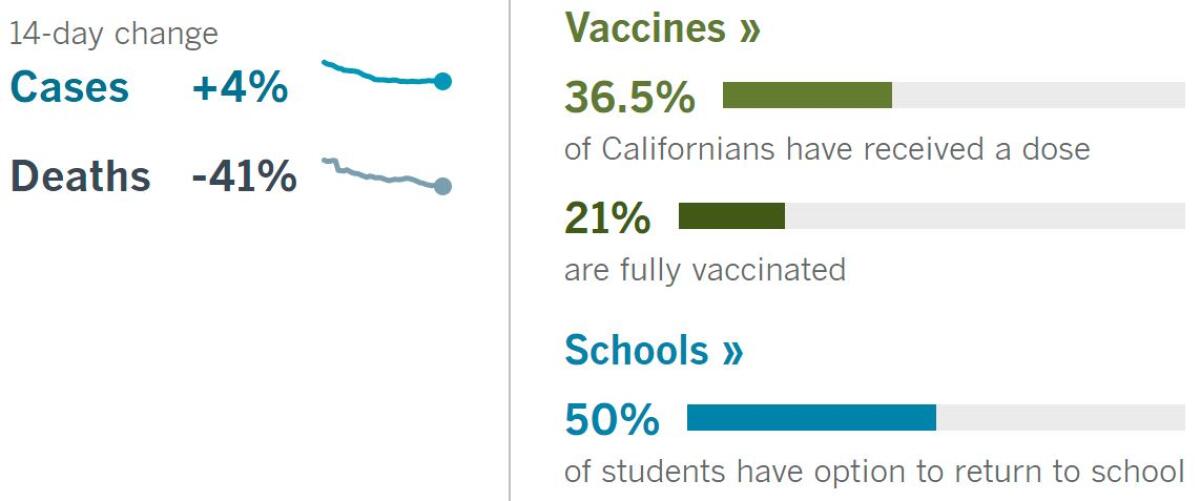
See the current status of California’s reopening, county by county, with our tracker.
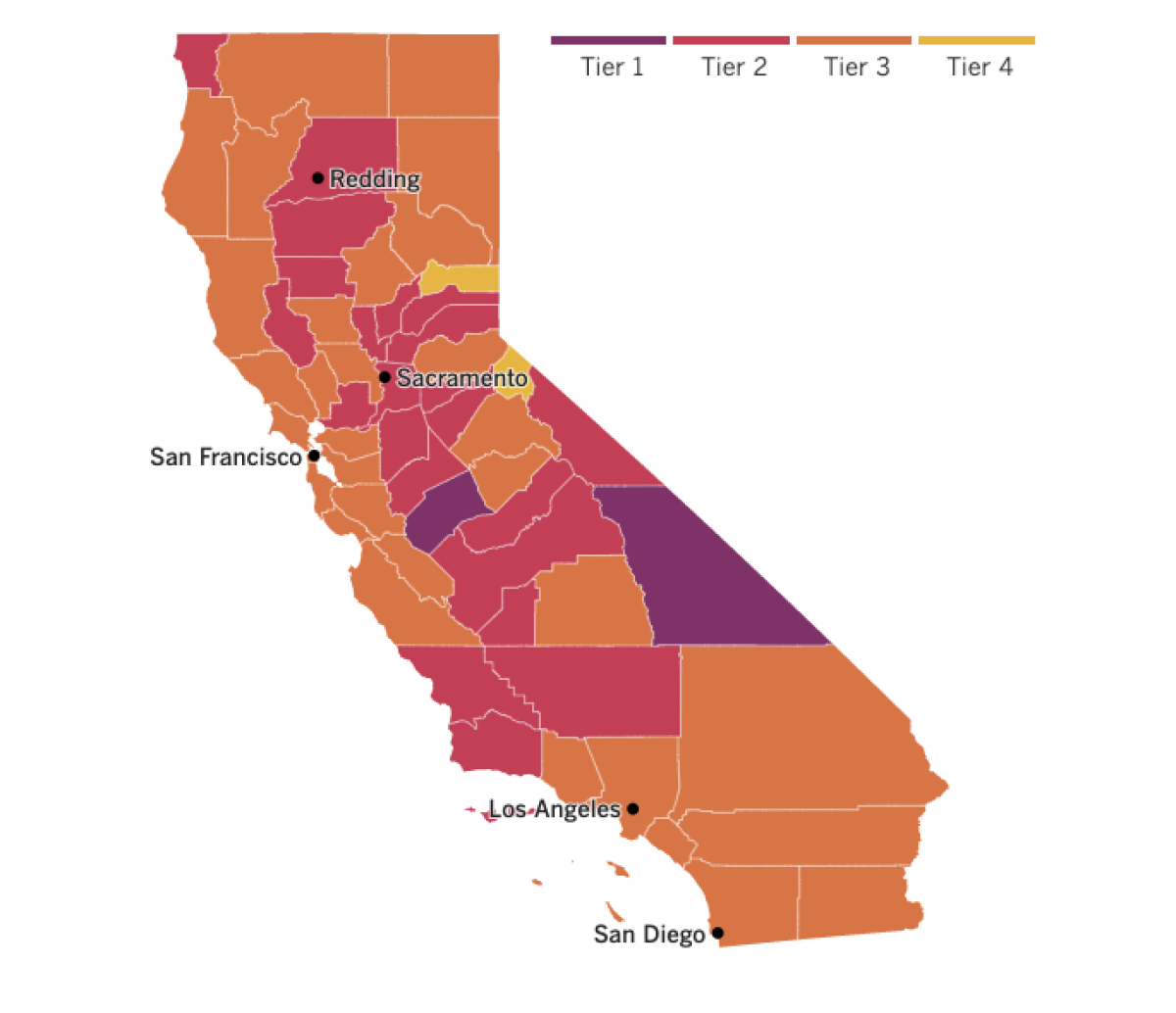

What to read this weekend
A Burbank restaurant goes to war against county health orders
Tinhorn Flats, a bar and grill in the city’s funky shopping district, has repeatedly defied government attempts to stop it from serving customers. When officials cut off power to the restaurant, the family that owns it installed a generator. When police placed a padlock on the door, the owner’s son sawed it off. Indeed, he was arrested three times in the span of six days.
The Burbank police chief said he “vehemently condemns” the “persistent unlawful behavior.” The city itself devoted an entire page on its website to its battle with the rogue restauranteurs. “This has been a challenging situation that may not be easily understood and resolved, especially when you are dealing with persons who willfully disobey the law,” the city said in a news release.
A lawyer for the restaurant owners likened the impasse to the Iraq War. “It basically looks like the siege of Fallujah over there — over outdoor dining,” he said. Be sure to check out this fascinating tale.
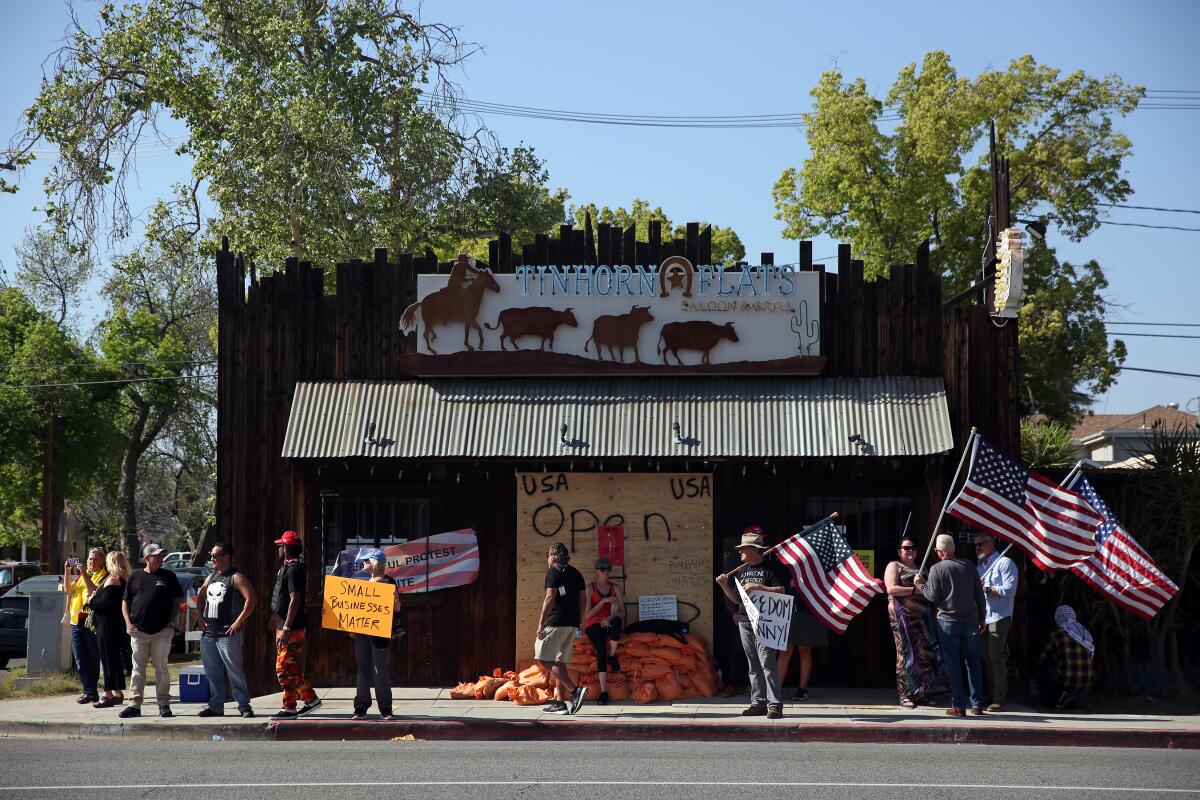
The fits and starts to California’s reopening
A typical business owner faced seven rule changes over the course of last year as officials in the state’s 58 counties tried to tame infections. The complex and constantly changing guidelines, tracked by The Times in a new database, created a whipsaw effect in which businesses were open one week, only to close again within days.
The frequent changes reflect the challenges the governor and local officials faced as they grappled with how to revive a collapsed economy despite the virus’ persistent spread. Our database focuses on five types of businesses: gyms, restaurants, retail, hair salons and nail salons. Multiplied across all of the counties and all five business categories, public health departments across the state made more than 2,000 rule changes.
How many jobs did a trillion-dollar loan program save? Nobody knows
The Paycheck Protection Program was pitched as a way to save millions of jobs threatened by the pandemic. But a year after Congress created the forgivable loan program, taxpayers still don’t know the number of jobs it preserved — because the government didn’t count.
This despite the fact that the Small Business Administration was legally required to do so. Early economic studies suggest the program did more to help businesses and their owners than it did for workers. One expert from the University of Chicago said it looks like the country could have gotten the same economic benefit at possibly half the price.
“We are spending money right now on this program,” said a policy analyst from the watchdog group Project on Government Oversight. “It’s never too late to start getting this information.”
“Hot pot is about family and togetherness”
With its large and diverse Asian immigrant population, the L.A. area is an epicenter of the cooking ritual of hot pot. There is Beijing Mongolian hot pot with lamb, Chongqing hot pot with chili and Sichuan peppercorn, and Taiwanese hot pot with a dipping sauce of satay and raw egg, among many others.
Hot pot meals can be large affairs. But during the pandemic, the groups gathered around the communal bubbling pot have grown smaller, extended families shrinking to threesomes or foursomes.
“Hot pot is about family and togetherness,” said San Gabriel Valley resident Howard Lee, who shared a hot pot for Lunar New Year with his wife and two children. “Before COVID-19, we would have cousins, aunts, uncles and grandparents over to eat. But at least we’re together.”
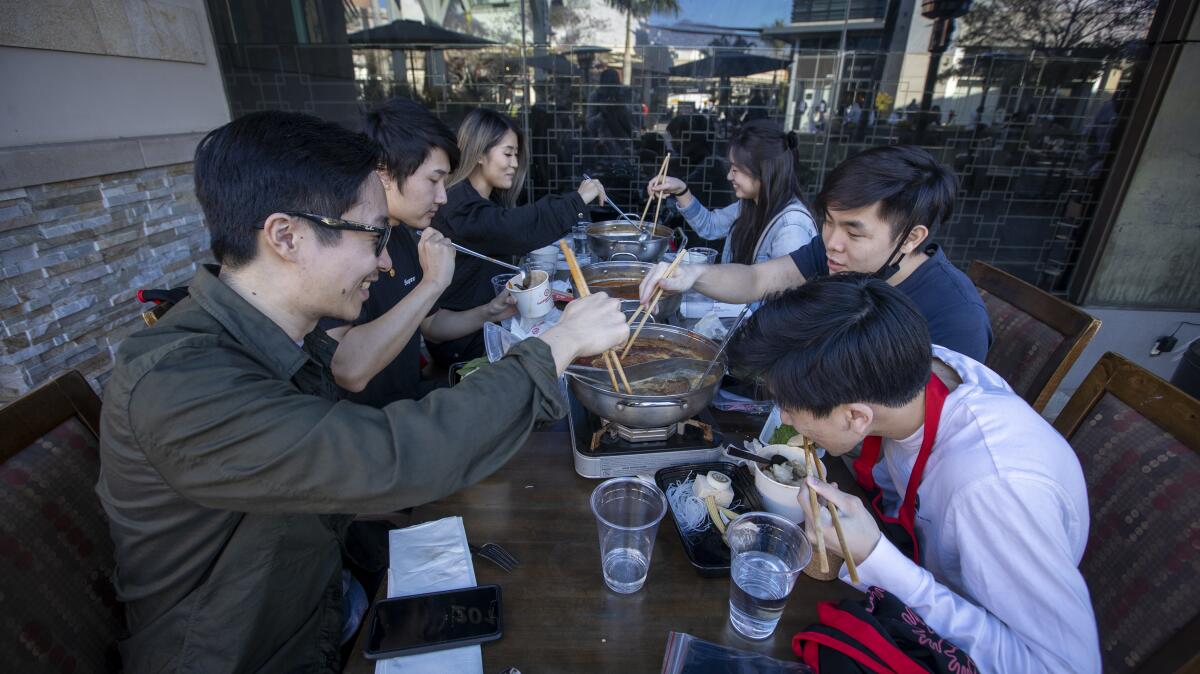
Prayers bring solace
From her apartment in West Adams, Rosalía González prays in the morning, again before going to sleep and once a week with dozens of others from her church. They pray for those suffering from COVID-19 and those who have lost a loved one.
In the U.S., more than half of adults say they have prayed for an end to the pandemic. Scientific opinion varies on the benefits of prayer, either as a form of intercession (asking for someone else) or petition (asking for oneself). It may help reduce stress and anxiety or provide other psychological benefits.
Richard P. Sloan, who studies behavioral medicine at Columbia University, noted that many hospitals across the nation integrate some form of spiritual service for patients. But he warned that “if you decide to just pray instead of going to the doctor you are risking your health by not getting the decent medical care you need.”
Your support helps us deliver the news that matters most.
What to do this weekend
Get outside. On Saturday night, a virtual forest will appear in downtown L.A., part of an outdoor digital light show called “Luminex: Dialogues of Light.” The exhibition is free and for one night only. Or take a walk under the real-life cherry blossoms at Descanso Gardens in La Cañada Flintridge, where the blooms are at their peak. Thinking of going camping? Here’s how to get a reservation. Subscribe to The Wild for more on the outdoors.
Watch something great. Our weekend culture watch list includes a screening of “Singin’ in the Rain,” the classic 1952 MGM musical, as the Hollywood Legion Theater reopens its indoor auditorium. And in his Indie Focus newsletter’s roundup of new movies, Mark Olsen writes about “Slalom,” directed by Charlène Favier and based in part on her own experiences as a young competitive skier.
Eat something great. Swoon at the new foods that ballparks are offering now that fans are allowed in the stands, including a michelada-spiced sausage with citrus slaw at Dodger Stadium. In our Cooking newsletter, Ben Mims offers recipes for those starting to entertain again now that the relaxed health orders make that a possibility.
Go online. Here’s The Times’ guide to the internet for when you’re looking for information on self-care, feel like learning something new or interesting, or want to expand your entertainment horizons.
The pandemic in pictures
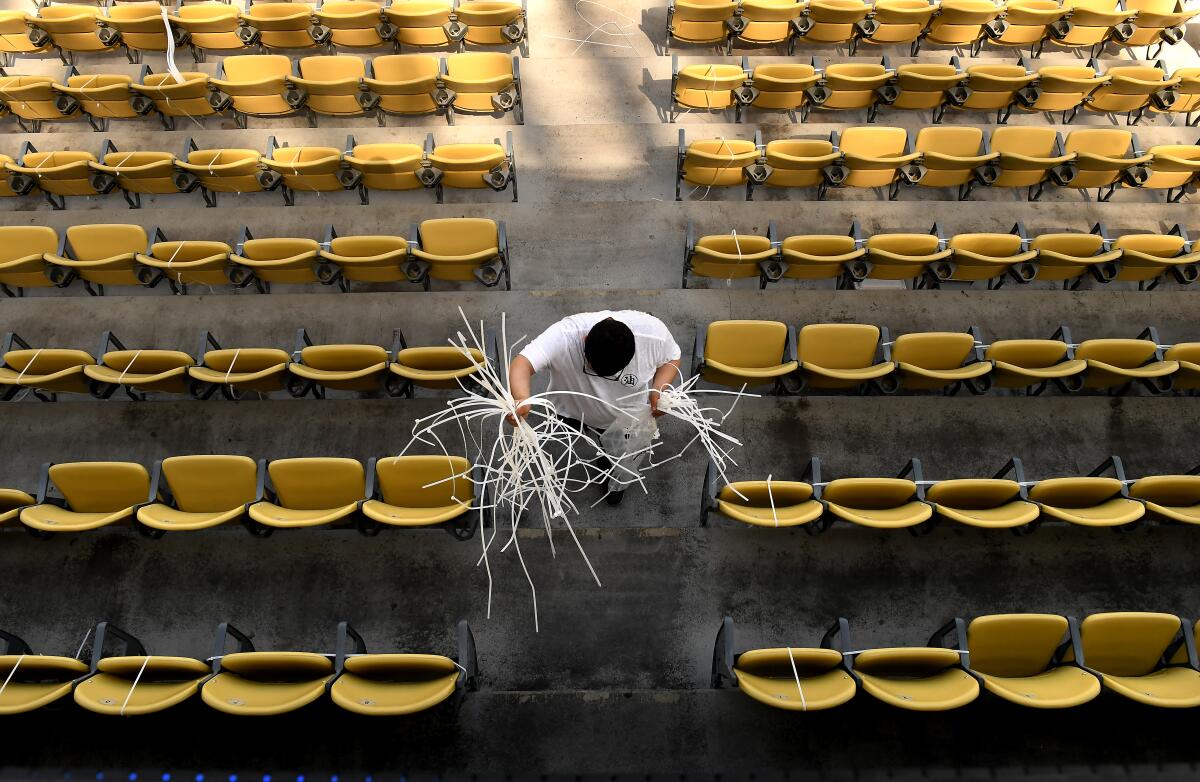
Baseball returned to Dodger Stadium on Friday, and for the first time in more than a year, there were real, live fans in the seats — but only in some of them.
Fewer than 15,000 spectators were on hand for the home opener, which the Dodgers won. The stadium could have welcomed roughly 3,600 more fans under orange-tier rules, but the limit was set to allow for sufficient social distancing, according to Dodgers President Stan Kasten. That’s why workers (like the one above) employed zip ties to prevent people from sitting too close to one another.
Those who came to root, root, root for the home team had to wear masks, order their Dodger Dogs and other concessions online from their seats to prevent crowds on the concourse, and pay for their food and other merchandise without using cash. No proof of vaccination or a negative COVID-19 test was required for entry to the stadium.
Dodgers utility player Chris Taylor said the idea of having fans back in the stadium was “kind of surreal.” Pitcher Clayton Kershaw’s feelings were more straightforward: “It’s kind of the first time we’ve all been together with fans to get to celebrate last year, so I’m very excited about it.”
If you’re planning to take in a game in the coming weeks, check out our guide before you go.
Resources
Need a vaccine? Keep in mind that supplies are limited, and getting one can be a challenge. Sign up for email updates, check your eligibility and, if you’re eligible, make an appointment where you live: City of Los Angeles | Los Angeles County | Kern County | Orange County | Riverside County | San Bernardino County | San Diego County | San Luis Obispo County | Santa Barbara County | Ventura County
Practice social distancing using these tips, and wear a mask or two.
Watch for symptoms such as fever, cough, shortness of breath, chills, shaking with chills, muscle pain, headache, sore throat and loss of taste or smell. Here’s what to look for and when.
Need to get tested? Here’s where you can in L.A. County and around California.
Americans are hurting in many ways. We have advice for helping kids cope, resources for people experiencing domestic abuse and a newsletter to help you make ends meet.
We’ve answered hundreds of readers’ questions. Explore them in our archive here.
For our most up-to-date coverage, visit our homepage and our Health section, get our breaking news alerts, and follow us on Twitter and Instagram.




